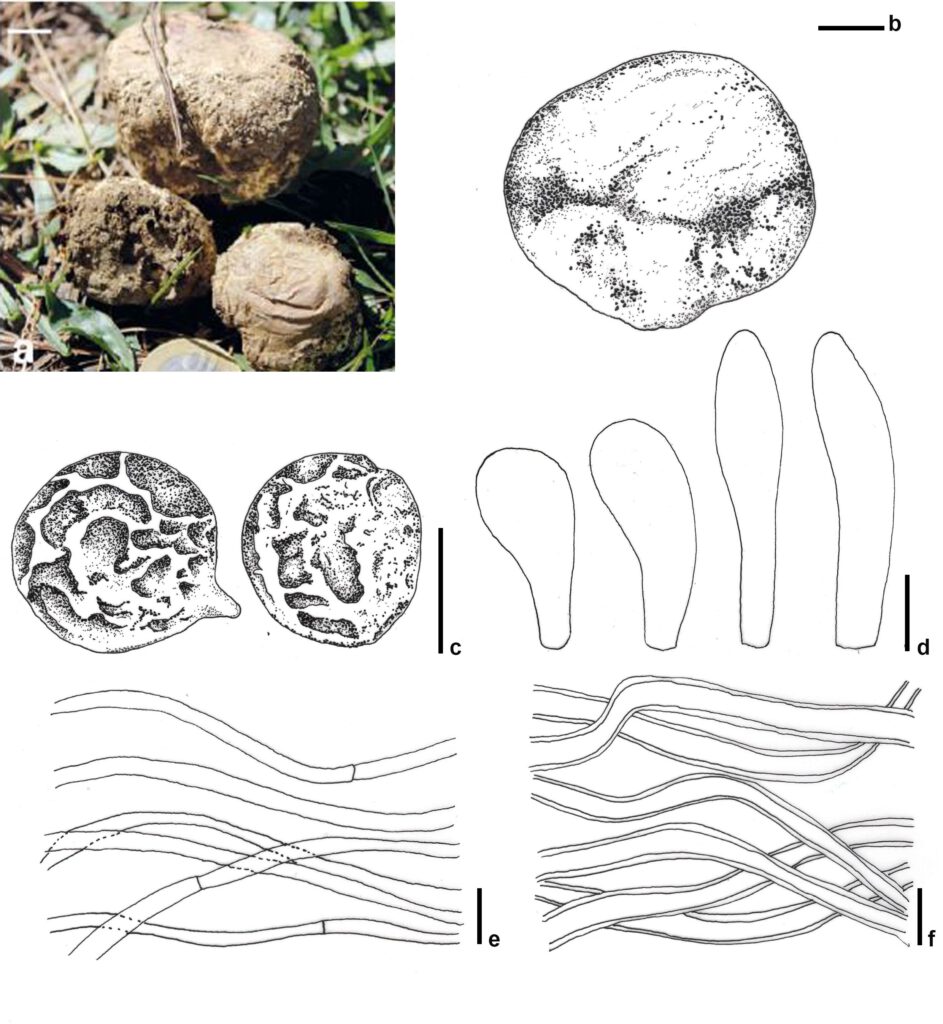Fungalpedia – Note 47 Abstoma
Abstoma G. Cunn
Citation if using this entry: Bera et al. (2023) Basidiomycota. Mycosphere (in prep)
Index Fungorum, Facesoffungi, MycoBank, GenBank, Fig. 1
The genus Abstoma was established by Cunningham (1926) under the family Lycoperdaceae incorporating the characters such as basidiomes without any determined stoma, a wavy capillitium, a peridium rupturing irregularly, and basidiospores with reticulate ornamentation. Later, both the smooth-surfaced and ornamented basidiospores were incorporated under Abstoma (Wright & Suárez 1990). Other characteristics of this genus that make it quite unique are its globose-shaped, deeply coloured basidiospores with conspicuous to obsolete pedicels, short and smooth threads of capillitium, and an exoperidium often intermixed with sand particles (Cunningham 1926, Wright & Suárez 1990, Gube & Dörfelt 2011). Abstoma represents the gasteroid macrofungi and is placed under the family Agaricaceae based mostly on molecular studies. This genus shows closer proximity towards another gasteroid member of Agaricaceae, Disciseda Czern. because of similar morphological characters (Moreno et al. 2007). But, the dehiscence of basidiospores in Disciseda occurs through a defined stoma which is completely absent in Abstoma (Moreno et al. 2007). The generally saprotrophic Abstoma has shown a wide distribution range from tropical forests and high mountains. Presently, there have been 11 species reported under this genus out of which A. purpureum (Lloyd) G. Cunn., A. reticulatum G. Cunn., A. stuckertii (Speg.) J.E. Wright & V.L. Suárez, and A. townei (Lloyd) Zeller are the species with reticulated basidiospores (Cunningham 1926, Wright & Suárez 1990, Rebreiv et al. 2014, Altaf et al. 2022).
Type species: A.purpureum (Lloyd) G. Cunn.
Other accepted species: A. fibulaceum Sosin
A. friabile G. Moreno, Altés, C. Ochoa & J.E. Wright
A. indicum Altaf, U. Singh & Y.P. Sharma
A. laevisporum J.E. Wright & V.L. Suárez
A. longii Zeller
A. pampeanum (Speg.) J.E. Wright & V.L. Suárez
A. reticulatum G. Cunn.
A. stuckertii (Speg.) J.E. Wright & V.L. Suárez
A. townei (Lloyd) Zeller
A. verrucisporum J.E. Wright & V.L. Suárez
Fig 1. Abstoma indicum (CAL 1866). a & b. Basidiomata. c. Basidiospores. d. Inflated elements. e. Exoperidial hyphae. e. Capillitium threads. Scale bars: a & b = 2 cm, c-f = 10 μm. Redrawn from Altaf et al. 2022.
References
Altaf U, Singh U, Verma K, Sharma YP 2022 – A new species of Abstoma (Agaricaceae) from Kashmir Himalaya, India. Nova Hedwigia, 89–98. https://www.schweizerbart.de/papers/nova_hedwigia/detail/115/101823/A_new_species_of_Abstoma_Agaricaceae_from_Kashmir_Himalaya_India
Moreno G, Esqueda M, Pérez-Silva E, Herrera T, Altés A. 2007 – Some interesting gasteroid and secotioid fungi from Sonora, Mexico. Persoonia-Molecular Phylogeny and Evolution of Fungi 19(2), 263–278. https://www.ingentaconnect.com/content/nhn/pimj/2007/00000019/00000002/art00007
Cunningham GH 1926 – Lycoperdaceae of New Zealand. Transactions and Proceedings of the New Zealand Institute 57, 187–217. https://biotanz.landcareresearch.co.nz/references/1cb0ebf5-36b9-11d5-9548-00d0592d548c
Wright JE, Suárez VL 1990 – South American Gasteromycetes IV. The genus Abstoma. South American Gasteromycetes IV. The genus Abstoma., 1(4), 372–383. https://www.cabdirect.org/cabdirect/abstract/20198608754
Gube M, Dörfelt H 2011 – Gasteromycetation in Agaricaceae sl (Basidiomycota): Morphological and ecological implementations. Feddes Repertorium 122(5‐6), 367–390. https://onlinelibrary.wiley.com/doi/abs/10.1002/fedr.201000025
Rebriev YA, Belaya EV, Dudka IA 2014 – The revision of the gasteromycetes proposed by PE Sosin as new for science which were validly published. Mikologiya i Fitopatologiy, 48(3), 195-201. https://www.cabdirect.org/cabdirect/abstract/20198653280
Entry by
Ishika Bera, Center of Excellence in Fungal Research, Mae Fah Luang University, Chiang Rai 57100, Thailand
(Edited by Kevin D Hyde)
Published online 9 June 2023
